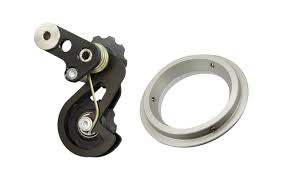What is a Chain Guide Tensioner?
2024-07-29
A chain guide tensioner is a mechanical device used to manage and maintain proper tension in a chain drive system. It plays a crucial role in ensuring the smooth operation and longevity of machinery that relies on chains for power transmission. Here’s a detailed overview of what a chain guide tensioner is, its functions, and its applications:
What is a Chain Guide Tensioner?
A chain guide tensioner is a component designed to regulate the tension and alignment of a chain in various mechanical systems. It prevents the chain from becoming too loose or too tight, which can lead to inefficient operation, increased wear, or potential failure of the system.
Key Functions:
1. Maintains Proper Tension:
- Ensures that the chain maintains the correct amount of tension throughout its operation. Proper tension is essential for efficient power transmission and to prevent slippage or derailment.
2. Reduces Chain Wear:
- Helps to minimize wear and tear on the chain by keeping it correctly tensioned, thus extending the lifespan of both the chain and the sprockets.
3. Prevents Slippage:
- Keeps the chain properly aligned with the sprockets, reducing the risk of the chain slipping off or skipping teeth.
4. Enhances System Efficiency:
- Contributes to the overall efficiency of the power transmission system by ensuring smooth and consistent operation.
Types of Chain Guide Tensioners:
1. Automatic Tensioners:
- Function: Automatically adjusts the tension of the chain as needed, using springs, hydraulic, or pneumatic mechanisms.
- Advantages: Requires less manual adjustment and maintenance, as it compensates for changes in chain length due to wear or temperature fluctuations.
2. Manual Tensioners:
- Function: Requires manual adjustment to set and maintain the correct tension in the chain.
- Advantages: Allows for precise control over tension but requires regular monitoring and adjustment by the operator.
3. Spring-Loaded Tensioners:
- Function: Uses a spring mechanism to apply constant pressure on the chain, adjusting automatically to maintain tension.
- Advantages: Simple design and effective for many applications. Often used in lighter-duty systems.
4. Hydraulic Tensioners:
- Function: Utilizes hydraulic fluid to apply pressure and adjust tension.
- Advantages: Provides precise control and can handle higher loads. Suitable for high-performance applications.
5. Pneumatic Tensioners:
- Function: Uses compressed air to adjust the tension of the chain.
- Advantages: Effective in applications where pneumatic systems are already in use and for adjustable tension settings.
Applications:
1. Automotive:
- Timing Chains: Maintains the correct tension in timing chains used in engine timing systems.
- Drive Chains: Regulates tension in chains used for driving auxiliary components such as camshafts or water pumps.
2. Industrial Machinery:
- Conveyor Systems: Keeps conveyor chain systems properly tensioned to ensure smooth operation and prevent slippage.
- Packaging Equipment: Ensures the proper functioning of chain-driven components in packaging machinery.
3. Agricultural Equipment:
- Harvesters and Tractors: Maintains tension in chains used in various agricultural machines to ensure reliable performance.
4. Bicycles and Motorcycles:
- Chain Drives: Regulates the tension in bicycle or motorcycle chains to ensure proper gear shifting and smooth operation.
5. Material Handling:
- Cranes and Hoists: Ensures the correct tension in chains used in lifting and material handling equipment.
Installation and Maintenance:
1. Installation:
- Positioning: Ensure the tensioner is correctly positioned relative to the chain and sprockets.
- Alignment: Verify that the tensioner is aligned properly to prevent misalignment issues.
2. Maintenance:
- Regular Inspection: Check for wear, damage, or improper tension regularly.
- Adjustment: Make necessary adjustments to maintain proper tension and alignment.
- Lubrication: Ensure that the tensioner and chain are properly lubricated to reduce friction and wear.
3. Replacement:
- Signs of Wear: Replace the tensioner if it shows signs of excessive wear, damage, or if it fails to maintain proper tension.
Choosing the Right Tensioner:
1. Load Requirements: Select a tensioner that can handle the load and operational demands of your specific application.
2. Chain Type: Ensure compatibility with the type of chain being used (e.g., roller chain, timing chain).
3. Environmental Conditions: Consider environmental factors such as temperature, humidity, and exposure to contaminants when choosing a tensioner.
By understanding the role and functionality of a chain guide tensioner, you can ensure efficient and reliable operation in systems that use chain drives. Proper maintenance and timely adjustments will help extend the life of your chain and associated components.



